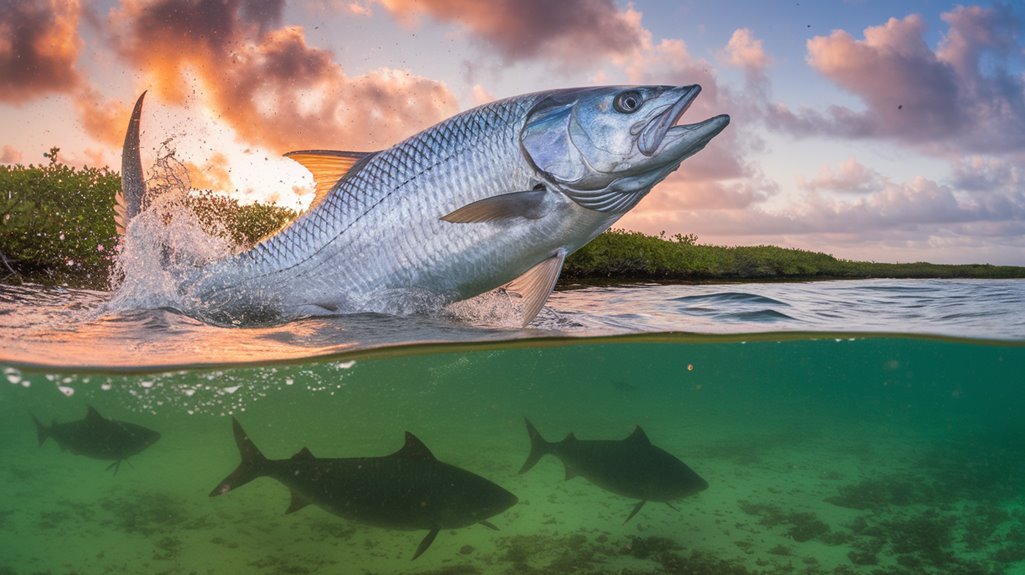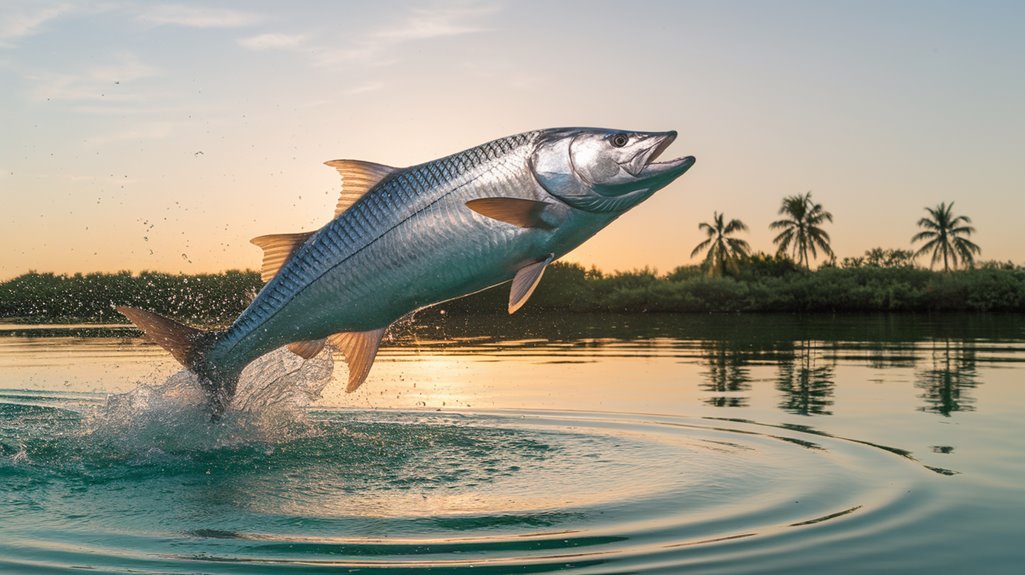If you're planning to target tarpon, you'll need to time your fishing trips with their migration patterns. These prehistoric gamefish follow specific routes and schedules that vary by region, making season selection essential to your success. You'll find these silver kings moving through the Gulf of Mexico, Atlantic Coast, and Florida Keys at different times throughout the year. Understanding when and where they'll appear can mean the difference between an epic catch and a frustrating day on the water.
Key Takeaways
- Peak tarpon fishing occurs from mid-March through July in the Gulf of Mexico, with April and May offering the best conditions.
- Atlantic Coast waters provide optimal tarpon fishing from June through August when water temperatures consistently exceed 75°F.
- Boca Grande and Florida Keys experience exceptional fishing during May and June, with high catch rates and tournament activities.
- Avoid January and February, as cold temperatures drive tarpon to seek warmer waters, resulting in low catch rates.
- Summer evening trips in July offer predictable feeding patterns, while spring months feature abundant bait options like shrimp and crabs.
Understanding Tarpon Migration Patterns
When planning your tarpon fishing adventure, understanding their migration patterns is essential for success. These majestic fish follow predictable seasonal movements driven by water temperatures and food availability. You'll find peak migration in the Gulf of Mexico from mid-March through July, while Atlantic waters see the highest activity from June to August.
If you're targeting prime fishing spots, head to Boca Grande, known as the "Tarpon Capital of the World." Its natural pass creates a perfect funnel for migrating tarpon. The Florida Keys offer year-round opportunities, but you'll experience the best action during peak migration periods when the waters warm above 75°F. These seasonal patterns aren't just random movements – they're calculated journeys as tarpon seek warmer waters and abundant food sources throughout their range.
Peak Fishing Months by Region
To maximize your chances of landing a trophy tarpon, you'll need to target specific regions during their peak seasons. Water temperature plays an essential role in ideal tarpon fishing, with the magic number being 75 degrees Fahrenheit or higher.
Here's when and where you'll find the best tarpon fishing opportunities:
- Gulf of Mexico: Peak season runs mid-March through July, with April and May offering prime conditions
- Atlantic Coast: Target migrating tarpon from June to August when they're most active
- Florida Keys & Boca Grande: While the Keys offer year-round opportunities, focus on mid-March to July, with Boca Grande's legendary Pass producing exceptional fishing during May and June
Remember that Boca Grande earns its title as "Tarpon Capital of the World" during these peak months, when its natural funnel creates perfect conditions for targeting these magnificent fish.
Weather and Water Conditions for Success
Understanding weather and water conditions can make the difference between a successful tarpon expedition and a frustrating day on the water. You'll find ideal fishing when water temperatures rise above 75 degrees Fahrenheit, as tarpon become more active and enthusiastic to feed.
During the tarpon migration season from mid-March to July, you'll experience increasingly stable weather conditions that improve your chances of success. June stands out as a particularly good time for targeting these magnificent fish, as the absence of cold fronts creates consistent fishing opportunities. The stable summer conditions of July, especially during evening trips, allow you to capitalize on predictable feeding patterns. Conversely, you'll want to avoid fishing during January and February cold fronts, when lower water temperatures drive tarpon to seek warmer waters.
Seasonal Bait Selection and Techniques
You'll find tarpon responding to different bait patterns as spring's mullet and pilchard migrations create feeding opportunities near the coastline. During summer months, switch to live bait options like crabs and shrimp, particularly during ebb tides when tarpon actively feed in shallower waters. As fall approaches, focus your bridge fishing efforts with artificial lures that match the local baitfish concentrations, keeping your retrieves slow and deliberate for ideal strikes.
Spring Bait Migration Patterns
As spring waters warm in the Florida Keys, massive schools of bait fish and crustaceans begin their annual migration, creating prime conditions for tarpon fishing. You'll find large migratory fish following these bait schools, especially during April and May when activity peaks near beaches and structures.
To maximize your success during spring's prime season, focus on these key patterns:
- Position your live bait, such as shrimp or crabs, up-current to mimic natural movement
- Target areas where bait congregates, particularly near structures and beaches
- Slow-retrieve artificial lures like Gator spoons to match spring feeding behaviors
With these patterns in mind, you can expect 7-12 hookups per day during peak May conditions, making spring the most productive season for targeting tarpon in the Keys.
Summer Live Bait Options
Live bait selection during summer months directly impacts your tarpon fishing success in the Keys. During this peak migratory season, you'll want to focus on proven options like shrimp, crabs, pilchards, mullet, and pinfish to entice these powerful gamefish.
When positioning your live bait, place it up-current during the ebb tide to create a natural drift that attracts tarpon. You'll need sharp hooks to compensate for their bony mouths, increasing your chances of a successful landing. Skip the floats when using shrimp, as they'll interfere with natural swimming patterns and may spook your target.
During your summer fishing trips, approach single tarpon or pods with stealth. Careful casting near these fish without startling them is essential for achieving more hook-ups and memorable catches.
Fall Bridge Bait Strategy
When fall temperatures arrive, successful tarpon fishing near bridges requires adapting your bait strategy to match seasonal patterns. You'll want to focus on live bait, particularly mullet and pilchards, as these baitfish congregate around bridges during their migration to warmer waters.
- Time your fishing trips for early morning or late afternoon when baitfish are most active and visible to feeding tarpon
- Use lighter tackle and line for better sensitivity, as fall strikes tend to be more subtle
- Employ a slow retrieval technique with your live bait to entice cautious tarpon
Tournament Schedule and Hotspots
Florida's premier tarpon tournaments pack the spring calendar from mid-March through late May, offering anglers prime opportunities to compete in prestigious events. You'll find the crown jewel at Boca Grande, the "Tarpon Capital of the World," where the World's Richest Tarpon Tournament draws competitors on May 22-23. The fishing hotspots include the natural funnel at Boca Grande Pass, where migrating tarpon congregate during peak season.
Don't miss the Ding Darling & Doc Fords Tournament on May 9-10 or the South Seas Tournament on May 17 at Captiva Island, both requiring $1,000 team entries. These events emphasize conservation efforts and eco-friendly fishing practices, ensuring sustainable tarpon populations. The tournament schedule aligns perfectly with prime migration patterns, maximizing your chances for successful catches.
Conservation Guidelines During Different Seasons

You'll need to adapt your tarpon fishing practices throughout the year to meet Florida's strict catch-and-release requirements, with special attention during peak migration periods from March through August. When monitoring your catches by month, it's crucial to track release times and fish conditions, helping you maintain compliance with FWC regulations while contributing to conservation data. During warmer months when tarpon are most active, you should use barbless hooks and minimize handling time to guarantee the highest survival rates for released fish.
Seasonal Release Best Practices
As seasonal changes impact tarpon behavior, proper release practices must adapt throughout the year to secure these magnificent fish thrive. During tarpon fishing season, you'll need to focus on eco-friendly fishing methods and proper techniques to guarantee sustainability.
- Use barbless hooks for catch-and-release fishing, especially during peak season (March-July), and minimize handling time to reduce stress on the fish
- In warmer water conditions, hold the tarpon upright while releasing, allowing sufficient time for recovery and proper gill movement
- During cooler months, limit your fishing activity and secure quick releases to prevent exhaustion
Catch Monitoring By Month
Understanding monthly catch patterns helps maintain sustainable tarpon populations while maximizing your fishing success. You'll find January and February yield low catch rates as tarpon seek warmer waters, making these months suboptimal for targeting these fish.
March signals the start of tarpon season in Islamorada as migratory patterns intensify and cold fronts diminish. April and May emerge as the best months for tarpon fishing, with April typically producing peak migration activity. During these prime months, you'll experience the highest catch rates of the year.
Frequently Asked Questions
What Month Is Best for Tarpon Fishing?
You'll find your best tarpon fishing in May, when the Gulf of Mexico sees massive migrations. April and June are excellent too, while Atlantic waters peak from June through August.
How Old Is a 100 Pound Tarpon?
Like counting rings in a tree trunk, you'll find a 100-pound tarpon is typically 10 to 15 years old, maturing at a growth rate of 1-2 pounds annually in its youth.
Where Is the Best Place in Florida to Catch Tarpon?
You'll find the best tarpon fishing in Boca Grande, Florida's "Tarpon Capital of the World." The natural funnel of Boca Grande Pass creates ideal conditions for catching these magnificent gamefish.
What Time Is Tarpon Most Active?
You'll find tarpon most active during dawn and dusk, especially in warm summer evenings when water temperatures exceed 75°F. They're particularly aggressive during their peak feeding times between March and July.
Conclusion
You'll find tarpon fishing's sweet spot is like hitting the jackpot at nature's casino – time it right and you're guaranteed heart-stopping action. Whether you're chasing these silver kings during the explosive Gulf migration or stalking them in the Keys' crystalline waters, success hinges on matching your timing to regional patterns. Remember the golden rule: respect seasonal regulations and release protocols to guarantee these magnificent fighters continue thrilling anglers for generations to come.

